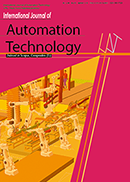Volume 17, Issue 5
Special Issue on the Latest Machine Tool and Manufacturing Technologies
Displaying 1-12 of 12 articles from this issue
- |<
- <
- 1
- >
- >|
Special Issue on the Latest Machine Tool and Manufacturing Technologies
-
Article type: Editorial
2023Volume 17Issue 5 Pages 433
Published: September 05, 2023
Released on J-STAGE: September 05, 2023
Download PDF (74K) -
Article type: Research Paper
2023Volume 17Issue 5 Pages 434-448
Published: September 05, 2023
Released on J-STAGE: September 05, 2023
Download PDF (6546K) -
Article type: Research Paper
2023Volume 17Issue 5 Pages 449-457
Published: September 05, 2023
Released on J-STAGE: September 05, 2023
Download PDF (3433K) -
Article type: Research Paper
2023Volume 17Issue 5 Pages 458-468
Published: September 05, 2023
Released on J-STAGE: September 05, 2023
Download PDF (3840K) -
Article type: Research Paper
2023Volume 17Issue 5 Pages 469-476
Published: September 05, 2023
Released on J-STAGE: September 05, 2023
Download PDF (2580K) -
Article type: Research Paper
2023Volume 17Issue 5 Pages 477-485
Published: September 05, 2023
Released on J-STAGE: September 05, 2023
Download PDF (2018K) -
Article type: Research Paper
2023Volume 17Issue 5 Pages 486-493
Published: September 05, 2023
Released on J-STAGE: September 05, 2023
Download PDF (2455K) -
Article type: Research Paper
2023Volume 17Issue 5 Pages 494-503
Published: September 05, 2023
Released on J-STAGE: September 05, 2023
Download PDF (3205K) -
Article type: Research Paper
2023Volume 17Issue 5 Pages 504-511
Published: September 05, 2023
Released on J-STAGE: September 05, 2023
Download PDF (2042K) -
Article type: Research Paper
2023Volume 17Issue 5 Pages 512-520
Published: September 05, 2023
Released on J-STAGE: September 05, 2023
Download PDF (1321K) -
Article type: Research Paper
2023Volume 17Issue 5 Pages 521-528
Published: September 05, 2023
Released on J-STAGE: September 05, 2023
Download PDF (2136K) -
Article type: Research Paper
2023Volume 17Issue 5 Pages 529-535
Published: September 05, 2023
Released on J-STAGE: September 05, 2023
Download PDF (1928K)
- |<
- <
- 1
- >
- >|
